#Doordash Food Data API Scraping Services
Explore tagged Tumblr posts
Text
Exploring Doordash API: Exciting Data Adventures!

Explore the universe of the food delivery industry in this blog, specifically focusing on Doordash and exploring the benefits of its API and Data Sets.
#restaurant data scraping#Exploring Doordash API: Exciting Data Adventures!#food data scraping services
1 note
·
View note
Text
DoorDash API - DoorDash Scraper - DoorDash Reviews API
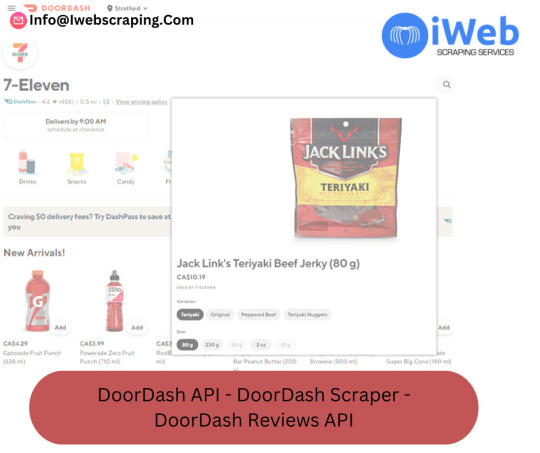
The digital age has transformed how we access services, including food delivery. DoorDash, a leading food delivery service, has not only revolutionized the way we order food but also offers a suite of APIs and tools for developers and businesses to harness its vast data. In this blog, we will explore the DoorDash API, DoorDash Scraper, and DoorDash Reviews API, highlighting their functionalities, use cases, and potential benefits.
DoorDash API
Overview
The DoorDash API provides a robust platform for developers to integrate DoorDash's delivery services into their applications. Whether you are running a restaurant, a logistics company, or a startup looking to offer delivery solutions, the DoorDash API can be a game-changer.
Key Features
Order Management: The API allows seamless integration of order placement, tracking, and management. Restaurants and businesses can manage their DoorDash orders directly from their existing systems.
Delivery Tracking: Real-time tracking of deliveries helps businesses keep their customers informed about the status of their orders.
Menu Management: Businesses can manage their menus, including item descriptions, prices, and availability, directly through the API.
Use Cases
Restaurants: Integrate DoorDash delivery into their own apps or websites, providing a seamless customer experience.
E-commerce Platforms: Offer on-demand delivery for non-food items, leveraging DoorDash's logistics network.
Logistics Companies: Enhance their service offerings with real-time delivery tracking and management.
DoorDash Scraper
Overview
A DoorDash scraper is a tool designed to extract data from the DoorDash platform. While scraping can be a contentious issue, with ethical and legal considerations, it remains a powerful method for obtaining data for analysis, market research, and competitive intelligence.
Key Features
Data Extraction: Scrapers can collect data on restaurant listings, menus, prices, customer reviews, and delivery times.
Automation: Automated scrapers can continuously gather data, ensuring that the information is up-to-date.
Customization: Users can tailor scrapers to collect specific data points based on their needs.
Use Cases
Market Research: Businesses can analyze competitor offerings, pricing strategies, and customer reviews to inform their own strategies.
Data Analysis: Researchers and analysts can use the data to identify trends, customer preferences, and market opportunities.
Inventory Management: Restaurants can track menu items' popularity and adjust their inventory and offerings accordingly.
Ethical Considerations
While scraping can provide valuable data, it is crucial to adhere to ethical guidelines:
Respect Terms of Service: Always check DoorDash's terms of service to ensure compliance.
Data Privacy: Avoid scraping personal data to respect user privacy and comply with data protection laws.
Rate Limiting: Implement rate limiting to avoid overwhelming the DoorDash servers and potentially causing service disruptions.
DoorDash Reviews API
Overview
Customer reviews are a goldmine of information, offering insights into customer satisfaction, preferences, and areas for improvement. The DoorDash Reviews API allows businesses to access and analyze customer reviews directly.
Key Features
Review Retrieval: Access reviews based on various criteria such as date, rating, and keywords.
Sentiment Analysis: Analyze the sentiment of reviews to gauge customer satisfaction and identify common pain points.
Actionable Insights: Use the data to make informed decisions on menu changes, service improvements, and marketing strategies.
Use Cases
Quality Improvement: Identify recurring issues in customer feedback and address them to improve service quality.
Customer Engagement: Respond to reviews directly through the API, showing customers that their feedback is valued.
Competitive Analysis: Compare reviews of your business with those of competitors to identify strengths and weaknesses.
0 notes
Text
How to Enhance Your Food Delivery Business with Data Scraping from Mobile Apps?
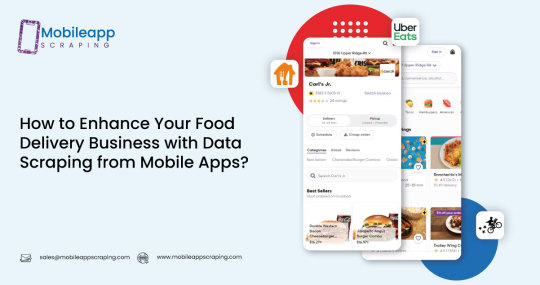
How to Enhance Your Food Delivery Business with Data Scraping from Mobile Apps?
July 29, 2023
Food Delivery Mobile App Data Scraping
Welcome to Mobile App Scraping's Food Delivery Apps Data Scraping service, designed to help businesses in the food industry unlock the potential of data. In the fast-paced world of food delivery, staying ahead of the competition requires access to real-time and comprehensive information from popular food delivery apps. Our specialized scraping service allows businesses to extract valuable data from these apps, including restaurant details, menu items, prices, customer reviews, delivery times, etc. With this valuable data, businesses can make data-driven decisions, optimize operations, enhance customer satisfaction, and gain a competitive advantage. Experience the power of data with Mobile App Scraping's Food Delivery Apps Data Scraping service and take your food business to new heights!
What Is Food Delivery Mobile App Data Scraping Service And How Does It Work?
Food delivery mobile app data scraping service refers to extracting relevant information and data from food delivery applications. It uses specialized tools and techniques to gather data such as restaurant details, menus, prices, customer reviews, ratings, and delivery information from popular food delivery apps.
Data Identification: The specific data points to be scraped from the food delivery app are identified based on the business requirements. This could include restaurant names, menus, pricing details, customer ratings, and reviews.
Scraping Methodology: A scraping methodology is developed based on the structure and layout of the food delivery app. This involves understanding the app's HTML structure, API calls, or other mechanisms to access and retrieve the desired data.
Scraping Execution: The scraping tool or script is executed to visit the food delivery app and extract the identified data points. The scraping tool simulates user interactions and navigates through the app's pages to collect the desired information.
Data Extraction and Transformation: The scraped data is extracted and transformed into a structured format that businesses can quickly analyze and utilize. This may involve cleaning the data, removing duplicates, and organizing it into a consistent format.
Data Delivery: The extracted data is delivered to businesses in the desired format, CSV, JSON, or database format. The data can be directly accessed or integrated into the business's existing systems or applications for further analysis and decision-making.
It's important to note that food delivery mobile app data scraping should be done in compliance with legal and ethical guidelines, respecting the terms of service of the app being scraped. Additionally, businesses should ensure they have the necessary permissions and rights to use the scraped data for their intended purposes.
Which Food Delivery Apps Can Be Targeted For Data Scraping?
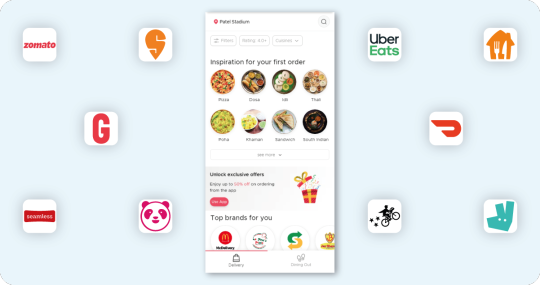
The food delivery apps that can be targeted for data scraping may vary depending on their accessibility and specific scraping capabilities. However, some popular food delivery apps that are commonly targeted for data scraping include:
Uber Eats
DoorDash
Grubhub
Postmatesa
Deliveroo
Zomato
Swiggy
Just Eat
Foodpanda
Seamless
These apps provide a wealth of data related to restaurants, menus, prices, customer reviews, ratings, and delivery information. However, it's important to note that scraping these apps should be done in compliance with legal and ethical guidelines, respecting the terms of service of each app. Additionally, the availability and accessibility of data for scraping may be subject to changes or restrictions imposed by the app providers.
What Types Of Data Can Be Extracted From Food Delivery Mobile Apps?
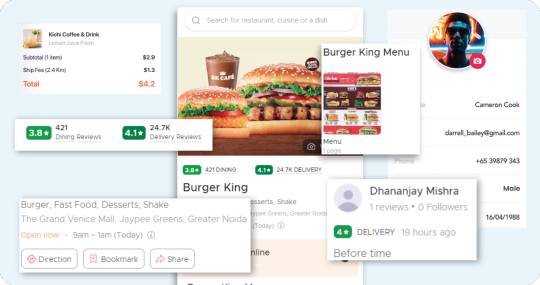
Food delivery mobile apps provide a wide range of data that can be extracted through scraping. Here are some common types of data that can be extracted from food delivery mobile apps:
Restaurant Details: Information about restaurants such as name, location, contact details, operating hours, and delivery areas.
Menus: The complete menu listings of restaurants, including item names, descriptions, prices, and available customization options.
Pricing Information: Details about the prices of individual menu items, combo meals, discounts, and delivery fees.
Customer Reviews and Ratings: Feedback and ratings provided by customers regarding their experiences with specific restaurants and dishes.
Delivery Information: Data related to delivery options, estimated delivery times, delivery partners, and tracking information.
Restaurant Images: Images and visual content associated with restaurants, menu items, and promotional offers
Cuisine and Dietary Information: Classification of restaurants and menu items based on cuisine types, dietary preferences (e.g., vegetarian, gluten-free), and allergen information.
Order History: Historical data related to customer orders, including order IDs, timestamps, order contents, and transaction details.
Promotions and Discounts: Information about ongoing promotions, discounts, special offers, and loyalty programs.
Restaurant Ratings and Popularity: Data indicating the popularity and ratings of restaurants based on customer feedback and order volumes.
Geolocation Data: Geographical coordinates or addresses associated with restaurants, enabling analysis of regional preferences and market trends
User Profiles: Basic user information, including names, addresses, contact details, and order history.
The availability and specific data types may vary across food delivery apps and their respective APIs or app interfaces. It's essential to adhere to legal and ethical guidelines and the terms of service of the app being scraped when extracting data from food delivery mobile apps.
How Frequently Is The Scraped Data Updated And How Is It Delivered To Businesses?
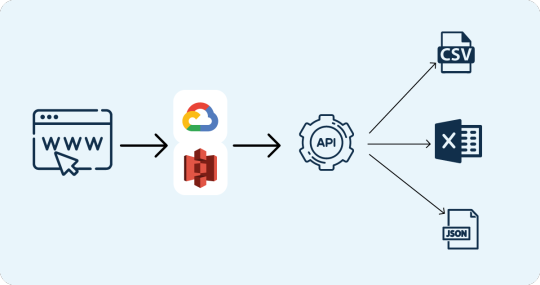
The frequency of data updates and the delivery method can vary depending on the specific requirements of the business and the scraping setup. Here are a few factors to consider:
Data Update Frequency: The scraped data can be updated based on the desired frequency, ranging from real-time to periodic updates. Real-time updates require continuous scraping to capture the latest data as it becomes available on the food delivery app. Periodic updates can be scheduled at specific intervals, such as daily, weekly, or monthly, to capture changes over time.
Delivery Method: The scraped data can be delivered to businesses in different formats depending on their preferences and needs. Standard delivery methods include:
a. File Downloads: The scraped data can be provided as downloadable files in CSV, JSON, or Excel. These files can be easily accessed and imported into the business's data analysis tools or systems.
b. API Integration: The scraped data can be delivered through an API (Application Programming Interface) that businesses can integrate directly into their systems. This allows for seamless and automated data transfer, enabling real-time updates and direct integration into existing applications or databases.
c. Cloud Storage or FTP: The scraped data can be stored in platforms like Amazon S3, Google Cloud Storage, or Microsoft Azure Blob Storage. Alternatively, businesses can deliver data through FTP (File Transfer Protocol) servers, where the scraped data is available for secure download.
Customization and Scheduling: The delivery of scraped data can be customized to align with the specific requirements of businesses. This may include filtering specific data points, generating reports, or customizing the data structure to meet the business's analysis or integration needs. Additionally, data delivery can be scheduled to occur at specific times or intervals to ensure timely updates.
Can The Scraping Service Extract Data Specific To Certain Locations Or Cuisines?
The scraping service can be customized to extract data specific to certain locations or cuisines from food delivery mobile apps. This customization allows businesses to focus on their target markets or culinary preferences. Here's how the scraping service can achieve this:
Location-Based Data Extraction: The scraping service can be configured to target food delivery apps for specific geographic locations. By specifying the desired cities, regions, or countries, the scraping service can extract data related to restaurants, menus, prices, and delivery options available in those particular areas. This enables businesses to gather localized data and gain insights into regional market trends and consumer preferences.
Cuisine-Based Data Extraction: The scraping service can be tailored to extract data based on specific cuisines. By specifying the desired cuisine types, such as Italian, Chinese, Mexican, or vegetarian/vegan options, the scraping service can retrieve information about restaurants offering those cuisines, their menus, pricing, and customer reviews. This allows businesses to focus on analyzing data specific to their chosen culinary domain and make informed decisions based on those insights.
Combined Location and Cuisine Filtering: The scraping service can also provide the capability to combine location and cuisine filtering. This means businesses can extract data for specific cuisines in particular locations, refining the scraped data to match their target market or customer preferences more accurately.
Businesses can obtain highly relevant and targeted information by customizing the scraping service to extract data specific to certain locations or cuisines. This enables them to better understand local market dynamics, tailor their offerings, and make strategic decisions that align with their target audience or culinary specialization.
How Can Businesses Benefit From Scraped Data From Food Delivery Apps From Mobile App Scraping?
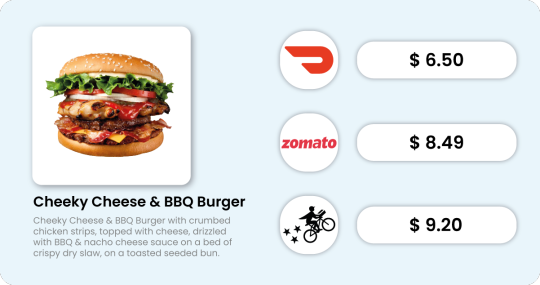
Businesses can benefit in several ways from the scraped data obtained from food delivery apps through Mobile App Scraping:
Market Analysis: The scraped data provides businesses valuable insights into the food delivery market, including popular restaurants, trending cuisines, customer preferences, and pricing trends. This information helps businesses identify market gaps, emerging opportunities, and potential areas for growth.
Competitor Analysis: By analyzing the data from food delivery apps, businesses can gain a competitive edge by understanding their competitors' offerings, pricing strategies, customer reviews, and delivery times. This allows businesses to benchmark their performance, differentiate themselves, and develop strategies to attract and retain customers.
Menu Optimization: The scraped data provides businesses with a comprehensive view of menus offered by various restaurants. This helps businesses optimize their menus by identifying popular dishes, analyzing customer reviews, and incorporating trending or in-demand items. By offering a well-curated and attractive menu, businesses can increase customer satisfaction and order volumes.
Pricing Strategy: The pricing data obtained through scraping allows businesses to analyze the pricing patterns of different restaurants and menu items. By understanding market dynamics and customer behavior, businesses can optimize their pricing strategies to remain competitive while maximizing profitability.
Customer Insights: The scraped data includes valuable customer reviews, ratings, and feedback. By analyzing this information, businesses can gain insights into customer preferences, satisfaction levels, and areas for improvement. This knowledge helps enhance the overall customer experience, address concerns, and foster customer loyalty.
Targeted Marketing: The scraped data enables businesses to target their marketing efforts effectively. By understanding customer preferences, popular cuisines, and ordering patterns, businesses can personalize marketing campaigns, offer relevant promotions, and drive customer engagement and conversion rates.
Operational Efficiency: The scraped data provides information about delivery times, order volumes, and customer feedback. This helps businesses optimize operations by streamlining delivery processes, managing resources efficiently, and improving overall service quality.
Strategic Decision-making: The insights from scraped data empower businesses to make data-driven strategic decisions. Whether expanding into new markets, partnering with specific restaurants, or introducing new menu items, businesses can leverage the scraped data to identify growth opportunities and mitigate risks.
Mobile App Scraping' scraped data from food delivery apps provide businesses with accurate and up-to-date information, allowing them to make informed decisions, improve operational efficiency, enhance customer satisfaction, and drive growth in the competitive food delivery industry.
What Level Of Customization Or Filtering Options Are Available For The Scraped Data?
Mobile App Scraping offers a high level of customization and filtering options for scraped data to meet the specific needs of businesses. Here are some of the customization and filtering options available:
Location-Based Filtering: The scraped data can be filtered based on specific geographic locations. Businesses can specify the desired cities, regions, or countries to focus on, ensuring that the extracted data aligns with their target markets or areas of interest.
Cuisine-Based Filtering: The scraped data can be filtered based on specific cuisines. Businesses can choose to extract data related to particular cuisine types such as Italian, Chinese, Mexican, vegetarian, or any other specific culinary preferences. This allows businesses to obtain data relevant to their chosen food categories and better understand customer preferences in those culinary domains.
Data Fields Selection: Mobile App Scraping allows businesses to customize the data fields they want to extract from food delivery apps. Businesses can select specific data points such as restaurant names, menus, prices, customer ratings, delivery times, and other relevant information. This level of customization ensures that businesses only receive the required data, making it more manageable and tailored to their specific needs.
Frequency of Data Updates: Data updates can be customized based on business requirements. Mobile App Scraping can provide real-time updates or schedule periodic updates at specific intervals, such as daily, weekly, or monthly. This ensures businesses receive the most current and relevant data to support their decision-making processes.
Data Format and Delivery: Mobile App Scraping offers flexibility in delivering the scraped data in various formats such as CSV, JSON, Excel, or through API integration. This allows businesses to receive the data in a format compatible with their existing systems and analytical tools, facilitating seamless integration and analysis.
Advanced Filtering and Sorting: Mobile App Scraping can implement advanced filtering and sorting mechanisms based on specific criteria, such as ratings, popularity, price range, or delivery time. This enables businesses to focus on specific subsets of data most relevant to their analysis and decision-making processes.
By providing a wide range of customization and filtering options, Mobile App Scraping ensures that businesses receive the scraped data tailored to their unique requirements. This empowers businesses to extract meaningful insights, make informed decisions, and drive their growth strategies more effectively.
Unlock the power of data for your food delivery business with Mobile App Scraping' Food Delivery Mobile App Data Scraping service. Gain a competitive edge by leveraging valuable insights from popular food delivery apps. Customize and filter the data based on locations, cuisines, and specific data fields to align with your business objectives. With real-time or periodic updates and flexible data delivery options, we provide you with the latest and most relevant information. Make informed decisions, optimize menus, refine pricing strategies, and enhance customer satisfaction. Take your food delivery business to new heights with Mobile App Scraping' Food Delivery Mobile App Data Scraping service. Contact us today to unlock the potential of your data-driven success.
know more: https://www.mobileappscraping.com/enhance-food-delivery-business-with-apps-scraping.php
0 notes
Text
How To Scrape Doordash Food Delivery Data Using Web Scraping?

The online segment of food delivery will reach $192 billion in 2025. These apps and platforms have thousands of hotel listings, and millions of customers use them.
If you want to succeed in your food delivery or restaurant business, data scraping is the solution that can assist you in fulfilling your objectives. Food chains and restaurants are using big data & analytics to know consumer tastes and preferences. You can use web data scraping services to gather data from food delivery platforms like Doordash for price adjustments, better marketing strategies, etc.
Why Scrape Doordash Food Delivery Data?

As the race amongst restaurants, food delivery platforms, and associated businesses is constantly rising, food delivery businesses need to capitalize on the data rapidly. Web scraping is processing massive amounts of data from targeted apps like Doordash. Data like food preparation time, delivery routes, etc., can optimize food delivery services and assist you in getting a competitive edge.
The scraped data from platforms like Doordash is usable in different ways. Let's go through some main reasons why you need to consider extracting Doordash food delivery data.
More Use in Customers
Find the Latest Restaurant Menus and Food Types
Better Marketing Strategies and Pricing
Customer Reviews and Rating Analysis
Complete Overview of Local Restaurant Industries
What Data Can You Extract from Doordash Food Delivery App?

You can scrape various data fields from well-known food delivery apps like Doordash. A few most common data points include:
Restaurant Name
Type
Address
City
Contact Information
Food Menu
Offers & Discounts
Menu Images
Working Hours
Reviews
Ratings
When you collect data, it's easy to clean and deliver in a well-structured format.
How to Use Scraped Doordash Food Delivery Data?
Here are some ways where you can use scraped Doordash food delivery data to improve your business strategies:
Restaurant Data
Observe open restaurants in the locality and analyze their brand presence with data like restaurant name, type, images, etc.
Discounts and Price Data
Beat the price competition by scraping data associated with offers and discounts. You can deal with a price strategy to ensure that your offering is competitive.
Ratings & Reviews
If you own a multi-place brand, you can recognize the quality gaps in every location and adopt your local brand strategy with data associated with ratings and reviews.
Opening Times
Discover which chains and services provide early breakfast or late-night deliveries by knowing the areas in which competition has limited working hours to benefit the market.
Updated Marketing Strategy
Optimize marketing campaigns and link up with micro-influencers depending on competitive pricing insights and data delivery fees.
Scrape Doordash Food Delivery Data with Food Data Scrape
The entire procedure of creating apps and websites has grown over the years. Contemporary websites or mobile apps follow no particular structure or rules. Even an objective behind web scraping could differ between businesses. Accordingly, a one-size-fits-to-all approach is rarely practical when choosing a web scraping solution.
The food industry is ever-changing, having competitive prices and features. A personalized web scraping solution like Doordash Food Data API Scraping Services from Food Data Scrape can assist you in monitoring Doordash data as per your needs. A web scraping API also ensures you have real-time data from apps and sites. Food Data Scrape creates custom data scraping APIs for different platforms which don't have a web scraping API to assist you in getting this.
Food Data Scrape can collect publicly accessible data from any place online and is among the top Doordash data scraping providers. Our pre-built scrapers help smaller businesses, analysts, and students collect data from well-known websites quickly and easily. For more information on web scraping Doordash data
For more information on web scraping Doordash data, contact Food Data Scrape now!
#Scrape Doordash Food Delivery Data#extracting Doordash food delivery data#Doordash Food Data API Scraping Services#Extract from Doordash Food Delivery App#Scraping Doordash restaurant data
0 notes